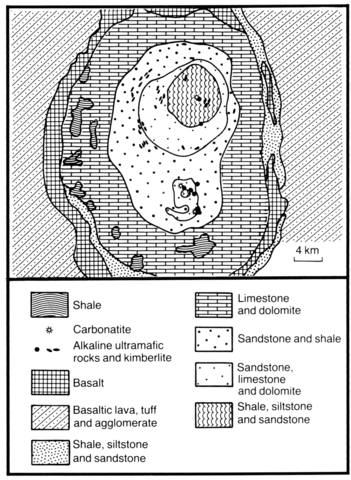stripes
The Chadobetskaya occurrences (Fig. 141) are located in the southwestern part of the Siberian platform. They include alkaline ultrabasic rocks which are closely associated with kimberlites (but see below) and belong to the Chadobetsky upland, which comprises two small domes formed by Riphean terrigenous and carbonate strata. The largest outcrops of the alkaline ultrabasic rocks, which are mostly as pipes, sheet-like bodies and dykes, are disposed in the central parts of the domes. According to geophysical evidence the igneous intrusions that have sheet-like forms have areas of up to 100x300 m and thicknesses of 50-70 m. The intrusions are formed of alnoites, micaceous melilite-nepheline peridotites and pyroxene peridotites. Sometimes they are intersected by veins of melteigite. Zoned veins are also found in which the central parts are formed of porphyritic picrites and the margins have phlogopite-apatite-pyroxene compositions. All the rocks are rather uniform in mineralogy the rock-forming minerals being forsterite, diopside-augite, phlogopite, ilmenite, apatite and perovskite. The quantitative relationships between these minerals is somewhat variable. In the porphyritic picrites forsterite comprises 22-45% of the volume of the rock; in phlogopite-olivine porphyries forsterite comprises 20-40% and phlogopite up to 15%, although usually the forsterite is totally replaced by secondary minerals. The groundmass of these rocks consists of diopside-augite together with phlogopite, apatite, magnetite, ilmenite, perovskite and other minerals. Secondary minerals, which are present in large quantities, include carbonates, generally calcite with some dolomite and ankerite, serpentine, chlorite, actinolite, limonite and others. Melilite-nepheline peridotites are fine- and medium-grained almost black rocks with a massive, and more rarely, irregular texture; they are sometimes porphyritic. The principal minerals comprising these rocks are forsterite, monticellite, nepheline, melilite, perovskite and, in some places, phlogopite. Amongst the accessory minerals are titanomagnetite and apatite. Carbonatites have been found in four occurrences. They are represented by series of veins, the thicknesses of which vary from several centimeters to 0.2-0.3 m, as well as irregularly shaped bodies. Both calcite and dolomite occur amongst the carbonates with the calcite carbonatites coarse-grained rocks which are essentially monomineralic. Albite, quartz, mica and pyroxene are present in insignificant amounts. Dolomitic carbonatites are more widespread and they contain small quantities of pyrite, iron hydroxides, apatite and accessory pyrochlore and sometimes sphalerite. Bagdasarov et al. (1969) give carbon isotope data on a range of carbonatites, carbonatite-like rocks and carbonate country rocks. Vasilenko (1989), based on the application of statistical methods and about 70 chemical analyses, considers that the rocks described as kimberlites are not so, but in fact melilitites.
*BAGDASAROV, Yu.V., GALIMOV E.M. and PROKHOROV, V.S. 1969. Isotopic composition of carbon in ankerite carbonatite and the source of carbonate material present in sedimentary rocks. Doklady Earth Science Sections, American Geological Institute, 188: 201-4.
BAGDASAROV, Yu.V., NECHAEVA, E.A. and FROLOV, A.A. 1972. Chadobetskaya province of ultramafic alkaline rocks and carbonatites. In A.I. Ginzburg (ed) Geology of the rare elements deposits. 35. Geology, mineralogy and genesis of the carbonatites. 79-91. Nedra, Moscow.
OSOKIN, E.D., LAPIN, A.V., KAPUSTIN, Yu.L., POHVISNEVA, E.A. and ALTUHOV, E.N. 1974. Alkaline provinces of Asia. Siberia-Pacific group. In L.S. Borodin (ed) Principal provinces and formations of alkaline rocks. 91-166. Nauka, Moscow.
POLUNINA, L.A. 1966. The Chadobetsky complex of ultrabasic-alkaline rocks. In. Geology of the Siberian Platform. 318-20. Nauka, Moscow.
VASILENKO, V.B., KRYUKOV, L.G. and KUZNETSOVA, L.G. 1989. Petrochemical types of alkaline-ultrabasic rocks of the Chadobetsky uplift. Geologiya i Geofizika. Novosibirsk, 8: 46-54.

